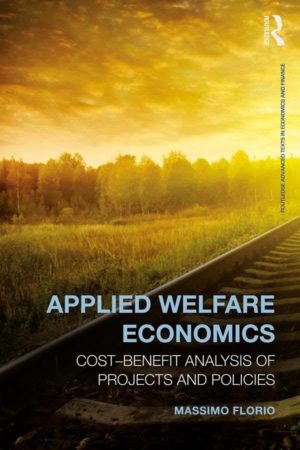Massimo Florio
‐ Professor of Public Economics ‐
Applied Welfare Economics
Cost-Benefit Analysis of Projects and Policies, Routledge, February 2014, authored by Massimo Florio.

What is the effect of a new infrastructure on the well-being of a local community? Is a tax reform desirable? Does the privatization of a telecommunication provider increase social welfare? To answer these questions governments and their policy advisors should have in mind an operative definition of social welfare, and cannot rely on simple official statistics, such as GDP. The price we observe are often misleading as welfare signals, and costs and benefits for the society should be based on ‘shadow prices’, revealing the social opportunity costs of goods and of changes of the world. This book explains how to apply these welfare economics ideas to the real world.
After a theoretical discussion of the concept of social welfare, a critical analysis of the traditional doctrine of welfare economics embodied in the Two Fundamental Theorems, and a presentation of social cost-benefit analysis, the book introduce the readers to an applied framework. This includes the empirical estimation of shadow prices of goods, of the social cost of labour and capital, the assessment of risk. This book also includes the state of the art of international experience with CBA, including ex-post evaluation of major projects, economic rates of return in different sectors, and a case study on privatisation, is presented.
This book offers a unique and original blend of theory, empirics and experience. The theoretical discussion clarifies why shadow prices are not virtual market equilibrium prices, as they arise as the solution of a planning problem, often with governments and economic agents constrained in their information and powers. The empirical chapters show how to compute proxies of the shadow prices in simple ways. The experience chapters draw from first hand research, gained by the Author and his collaborators over many years of advisory work for the European Commission and other international and national institutions.
Click here to know more.
Review:
“I learned a lot from this book. It is an important triangulation point on the nature of applied welfare and benefit–cost analysis (BCA). This triangulation is due to its general equilibrium foundation and European primacy of focus, both of which differ from standard US texts on the subject. I think the book will be most valuable as part of an economics graduate course on welfare analysis or for the large practitioner community already involved in doing BCA. The book is clearly written with explanatory ‘break-out boxes’ that help keep the core text from being too abstract, as do several chapters on empirics and the four concluding chapters on practice in Europe including ex-post (retrospective) analysis. […]”
(2014) Applied Welfare Economics: Cost–Benefit Analysis of Projects and Policies, Regional Studies, 48:12, 2020-2021.


